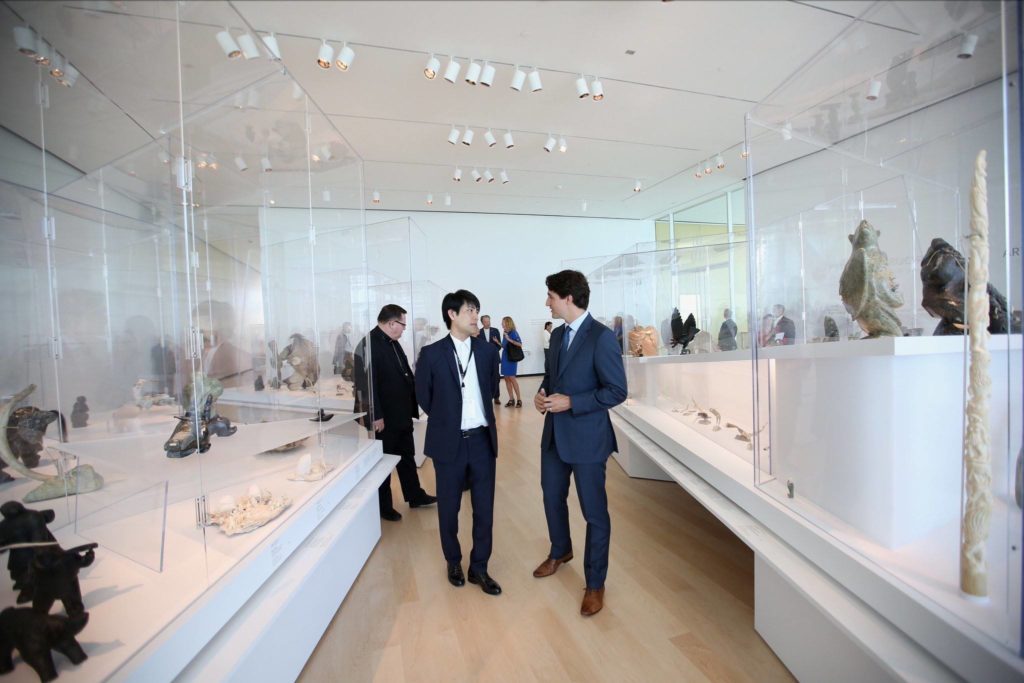Massacre of the Innocents by Peter Paul Rubens at the Art Gallery of Ontario. A cabinet and dresser, “so rare as to be unique,” by Charles Rennie Mackintosh at the Royal Ontario Museum. Paintings by Jan Breughel the Elder and Edgar Degas at the Montreal Museum of Fine Arts.
These are just some of the sublime artworks that have been donated to Canadian museums under the auspices of the (prosaically named) Cultural Property Export and Import Act (CPEIA). Since the act was developed in 1977, many Canadian museums have been leveraging it to snag significant art donations—arguing that, under the act, such artworks were of sufficient “national importance” to earn art donors a tax credit for the market value of their donated artwork. But in the wake of a recent federal court ruling that narrowed the definition of “national importance” in the act, it’s unclear whether such works could have been donated in the same way today: essentially, it’s doubtful they would now qualify for “national importance” status, so museums wouldn’t be able to secure tax receipts for the donors—hence no donations. Not surprisingly, Canadian museums are now raising the alarm bell about the recent ruling.
“Urgent action is required: Already, donations that were in progress—even from recognized Canadian collections—have been frozen, preventing our institutions from acquiring major works,” reads a letter released to the public this week by eight major museum leaders. Even though the Attorney General has already filed an appeal on the federal court ruling in question, the museums’ letter asks the government to speed it up: “In this critical situation, we request that the federal government expedite the appeals process. Each day counts.”
The controversial federal court ruling, released in June 2018, reversed the judgment call of the usual decision-maker on these fronts—the expert-led Cultural Property Export and Review Board (CPERB), in action since 1977—in favour of auction house Heffel. And the ruling interpreted “national importance” in Canadian law much more narrowly than CPERB has in decades past. The upshot: a drying up of Canadian museum artwork donations, and a risk, museums say, of losing more of these works to the international market.
But is it the June ruling, or the law itself, that needs to change? Yes, since the Cultural Property Export and Import Act was created decades ago, Canadian museums have come to rely upon it to build collections with donated, tax-credited artworks—some of them quite prominent and famous. And that legal mechanism has been a much-needed tool for museums in the absence of decent acquisition budgets. But does all that mean there is actually nothing wrong with the act itself, or with its past implementation? It’s possible the current crisis offers an opportunity to revise the law to the benefit of Canadian museums and markets alike.
The past year has highlighted multiple problems with the Cultural Property Export and Import Act and its interpretation and implementation.
For one, the act has been very inconsistently interpreted and implemented: One expert examiner, Art Gallery of Greater Victoria curator Michelle Jacques, blocked a $600,000 Caillebotte that had only ever been in Canadian private collections from export. But another expert examiner, Art Gallery of Ontario assistant curator of modern art Kenneth Brummel, permitted a $6-to-9 million Chagall that had been in a public collection for decades to be exported.
Some legal scholars have criticized the wording of the act as too general when it comes to regulating works of, as the act puts is, “outstanding significance” and “national importance.” Robert Paterson, a University of British Columbia law professor, told the Globe and Mail, “There’s no doubt about it, these [criteria] are incredibly vaguely written… Who knows what ‘outstanding significance’ means. They’re applying, to some extent, aesthetic and quasi-political considerations that can almost mean anything anyone wants them to mean.”
And other experts have pointed out in the wake of the June ruling that Canada’s Cultural Property Act is different from international law on the same topic—and they question whether that difference, especially in light of the recent court interpretation, is actually necessary. Part of the Canadian act, writes Alex Herman of London’s Institute of Art and Law, mirrors the UK’s own Waverley criteria for determining cultural property of outstanding significance. “However, when Canada passed the CPEIA in the 1970s, it decided to include a second branch, that of ‘national importance,’” Herman explains.
Even the judge in the June ruling, Michael Manson, noted that the Canadian law was much more specific than international law: “Parliament has never adopted the much broader definition of cultural property found in the Convention for the Protection of Cultural Property in the Event of Armed Conflict, The Hague, 14 May 1954,” Manson writes. “The Convention refers to ‘cultural property’ as objects ‘of great importance to the cultural heritage of every people.’” But the Canadian law requires the object to have “national importance” as well.
Those involved with Canada’s art markets have also had complaints for some time about the implementation of the act, if not its exact wording. After all, it was one of Canada’s largest auction houses, Heffel, that brought the milestone case to court this year in the first place, contesting an expert examiner and related board judgment on the Caillebotte mentioned above. Heffel had originally sold the Caillebotte to a UK buyer, but the examiner and board blocked it from export, finding it, yes, to be of “outstanding significance” and “national importance.” Though Heffel declined to comment on the case, court ruling and appeal, it’s not hard to see how, now that live streaming and internet bidding have technically given it access to international buyers, that it is trying to preserve that access legally as well.
Other art dealers have been more forthcoming about their complaints on the way the current law is implemented. In a blog post written shortly after the June 12 decision, longtime art dealer Alan Klinkhoff argues that Canada’s Cultural Import and Export Review Act, and its decision-making bodies like CPERB, have too often been used as “a discount shopping basket for museums.” “If a work meets [a curator’s] collecting interests,” Kinkhoff wrote, “with some creative prose they can block the work [from export] and attempt to make its purchase cheaply with money they don’t already have by applying for a Movable Property Grant”—the latter being a specific kind of Canadian Heritage grant to which designated organizations can apply to acquire a work for which CPERB has delayed an export permit.
In a phone interview, Klinkhoff elaborated on his perspective. As the Canadian art market tries to expand its reach internationally, Klinkhoff says that CPERB’s initial decision to retain the Caillebotte domestically after its sale to a UK buyer “makes us look like a banana republic.” In a milieu where cultural export is being pushed by a federal government, Klinkhoff also says there is a further argument there to be made. “It’s not like demand is large for [Canadian art] outside of the country—but we can never know if there is demand if it takes get 5 or 6 or 7 weeks to get permission to export a nice A.Y. Jackson,” says Klinkhoff. “So what if a Spaniard or American wanted to buy a really great Emily Carr—wouldn’t it be great to export some of our culture and share it with other nations? We’ve got lots.”
Alex Herman of the Institute of Art and Law, in his own recent blog post on the matter, also notes that an “unusual feature of the Canadian legislation is that the criteria for export controls are the same as those for certifying cultural property for individual tax deductions”—that is, criteria for donating a large Rubens painting to a museum and for exporting a small French Impressionist canvas are one and the same. Is it possible these should at last be extricated and separated as is the case with the law in many other nations?
Before recommending or exploring potential changes to the Cultural Property Export and Import Control Act, it is worth acknowledging how important it was for Canada to develop and implement the act in the first place.
Sharilyn Ingram, a former Brock University professor and current chair of the Canadian Cultural Property Export Review Board, notes that when it was written in the 1970s, the Canadian act had international precedents—as well as recent Canadian cultural losses—to consider.
“The history of the act was catalyzed by the passage of the UNESCO Convention on Cultural Property in the early 1970s and the signatories had to have a domestic framework in place,” Ingram explains. “But besides that, the act had been stimulated by the fact that a couple of large Canadian collections left the country and had been sold at auction in the States, and the government realized that it didn’t have the power to affect that.”
The general nature of the wording in the act was also regarded as a plus, rather than a minus, at the time. “The concept of nation and the concept of what is important culturally evolves over time,” says Ottawa art appraiser Erica Claus, a former officer and secretary of CPERB herself. “So the writers who conceived of this Act were quite prescient in keeping the language broad enough to allow for flexibility in interpretations that are relevant globally and not limited to a provincial application.”
Yet what the writers of the act might not have foreseen in the 1970s and 1980s is the way that statutory or legal interpretations in general might shift over the decades to favour less flexible wordings and interpretations. And because this year’s court case was the first in 40 years to actually test that wording and its interpretation, this year is also the first opportunity the art world has really had to find that out.
The Cultural Property Export and Import Act is currently dated 1985 in government records, but in his June 2018 ruling, federal judge Michael Manson referred, in his decision, to 1998 case law and a 2014 legal tome that, he says, encourages avoiding any legal “interpretation that would render any portion of a statute meaningless, pointless or redundant”—and to his judicial mind, conflating “outstanding significance” with “national importance” as listed in the act is redundant, even if the art world often sees it the opposite way.
As a result, Judge Manson made efforts in his ruling to come up with a definition of an artwork’s “national importance” that would not redundantly overlap with that of “outstanding significance” of an artwork. Citing the Canadian Oxford Dictionary, he stated that national importance had to be “of or pertaining to a nation or the nation, especially as a whole” and “peculiar to or characteristic of a particular nation.”
To many (especially, but not only, museum folks) the judge’s resulting definition of Canadian heritage and Canadian-ness is much too narrow. “Would art from Africa, the Americas or Asia not be considered representative of our collective history? How can we exclude the cultures of the world from the building of our Canadian society, when that society is characterized by its very diversity?” the letter made public by eight museum leaders asks. “Will we have to explain to the coming generations that international works of art—whether in the form of ancient Egyptian or Greek sculpture, a collection of Japanese or Chinese calligraphy, or contemporary works by Warhol or Basquiat—are to be banished from the Canadian imagination from now on? How are we to build an inclusive Canada when, at the highest national level, we reject donations of works by international masters, as well as refuse, going forward, to protect them from export?”
I agree with these critiques; I too think that the definition Manson offers of Canadian heritage is much too limited. Yet there is still a problem here. If “outstanding significance” of an artwork is part of what, in the art world, intrinsically lends it “national importance,” and if case law has brought about a need to avoid redundancy in law, why don’t we just bring our Canadian law into line with international law and remove the “national importance” requirement from our cultural property act altogether?
This is precisely what art and law expert Alex Herman himself proposes in his recent writings: “The answer to … the legitimate concerns of the eight museum directors, may not in the end lie in judicial appeal, but in amending the words of the CPEIA itself. This could be done through the (relatively uncontroversial) removal of s. 11(1)(b) of the Act”–which refers specifically to “national importance,”—“as well as any references thereto.”
Another option in terms of making the process clearer and fairer for all, as well as the law, would disentangle the parts of the law dealing with criteria for art export—which is what Heffel filed its case on—from the parts of the law dealing with criteria for donating artworks to museums and institutions on a tax-receipted basis, which is what the museums essentially wrote their open letter about. As Herman also points out in his blog post, the pairing of these things now within Canadian law is anomalous compared to other jurisdictions.
As for concerns the market has voiced, and other problems, art appraiser and former CPERB officer and secretary Erica Claus suggests that the law be changed to raise the financial value that triggers an export-permit review. “One of the things that really needs to be updated are the outdated export control value limits, because they are severely outdated,” says Claus. Dealers “are quite right is to say that the value limits are afar too low—for fine art it is $35,000, and that doesn’t make any sense any more. In an international art market, 35K doesn’t get you very much at all.” The result is that many more works get caught up in the export review process than need to be caught up in it in 2018, says Claus.
Claus also says there are actions that can and should be taken to make interpretation of the Cultural Property Act criteria more consistent on the part of expert examiners spread across the country. On this front, the interpretation guidelines given to all these examiners need to be rewritten and rethought: “I think that the interpretation of national significance needs to be clearly explained,” says Claus. “At present, it is not.” And once those better interpretive guidelines are written, says Claus, the expert examiners need to be trained in them, perhaps through a collective conference or conversation. “If I were to say I hope something else comes out of this, I hope it will be, ‘Let’s get the expert examiners all on the same page.’” Claus says.
Still, Claus is clear-sighted on the fact that changes to the law and its interpretation won’t necessarily solve decades-long tensions between private businesses’ drives to market expansion and museum sectors’ drives to collection building. “I think that is a dilemma that will always have some tension in it,” says Claus “no matter what we do in export control.” Nevertheless, the changes she suggests to the law could help ameliorate the situation.
But what is the likelihood of Heritage Minister Pablo Rodriguez and his colleagues actually bringing a revision of Canada’s Cultural Property Act to Parliament? Or that Canada’s museums bother to push for such a revision themselves given the way that they have benefitted, collection wise, from the wording, interpretation and implementation of the existing act in the past?
Really, the chances for that are not great given that the Heritage Ministry kept its distance from the Chagall-export scandal earlier this year, citing an arm’s length relationship with the issue. Lesser chance still, maybe, given that the feds, with some fanfare, launched its cultural export strategy this spring, and Justice Manson’s decision is in many ways aligned with favouring market export.
And if museums want the public to get behind their rallying cry for collection-building, they may need to consider whether the public really benefits as much as it did from that collection-building as it did back in the 1970s and 1980s when Canada’s Cultural Property Act seemed much more urgent. Back then, to see a Rubens or a Mackintosh or a Breughel or a Degas in a public museum collection in Canada didn’t tend to cost the public anything in terms of admission fee. Now, it usually costs $15 to $20 for the pleasure, weakening the museums’ implication that what they do is always in the public good—and summoning the further implication that museum curators should have access to famed artworks, even if everyday Canadians don’t.

 Justin Trudeau visits the Musée des beaux-arts du Québec in 2016. This week, a letter signed by Christiane Germain, chair of that museum, was released to the public, demanding that the federal government speed up an appeal affecting museum donations. Photo: Facebook.
Justin Trudeau visits the Musée des beaux-arts du Québec in 2016. This week, a letter signed by Christiane Germain, chair of that museum, was released to the public, demanding that the federal government speed up an appeal affecting museum donations. Photo: Facebook.







